6/14/10
5/1/09
Labor Day: Yeh bacha kis ka bacha hai
| Labor Day: Yeh bacha kis ka bacha hai Roshan Malik and Adil Najam
Yeh Bacha Kis Ka Bacha hai (’whose child is this?’) is the title and the refrain line from a famous poem by Ibn-i-Insha. Most people know Insha for things like ‘Insha ji utho, aab kooch karo’ or ‘kal chodhweiN ki raat thi’ or ‘yeh baataiN jhooti baataiN haiN’. In fact, most people would not think of ‘yeh bacha kis ka bacha hai’, with its characteristically Insha simplicity, the greatest work of the poet, columnist and humorist. It is, however, a moving piece that Insha ji had written upon seeing the photo of a starving Ethiopian child during the devastating famine of the seventies. However, a new video rendition this poem just released by the advocacy group Actionaid Pakistan, and directed by Matteela, has not only done amazing justice to the poem but has uncovered layers upon layers of emotive meaning that may have been missed by too many readers. Even if you read and see nothing else on this site, we urge you to view this short video rendition, and to think deep and hard about both the words and the images. Click on arrow at center, or view it directly here: There is some wonderful information about the song at Matteela’s website, including this:
The disparity between haves and have nots is widening rapidly in urban areas of Pakistan. These vulnerable street children sometimes involve into the criminal activities and are destined to face the juvenile trial. In Pakistan, more than 4000 children under the age of 18 are facing juvenile trial in the courts. The miseries of poor children in Pakistan are quite similar with other South Asian countries. UNICEF reports that more than 3.6 million children under the age of 14 are working under hazardous and exploitative conditions in Pakistan. It also says that child abuse cases reported in Pakistan during 2000-04 were more than 17000.
The worst form of Child Labor identified by ILO Pakistan are Gawadar Deep Sea Fishing, Hyderabad Glass Bangle Industry, Surgical Industry Sialkot, and Tannery Industry in Kasur:The ILO Rapid Assessment on Rag Pickers/Scavengers conducted by the Sustainable Development Policy Institute (SDPI) reveals that there are roughly 89,500-106,500 children engaged in scavenging in five major cities of the country i.e. Karachi, Lahore, Quetta, Peshawar and Islamabad. Roshan Malik is a development practitioner with wide experience in Pakistan. The concept, information and original post is by him. |
Read more...
4/28/09
Taliban Times
| |
| Adil Najam
Analyses boggle the mind because just keeping up with the news is hard enough. So, here are excerpts from just a few of recent news reports that are worth a read.
|
4/24/09
Traveling in Style: What Are They Thinking
Adil Najam
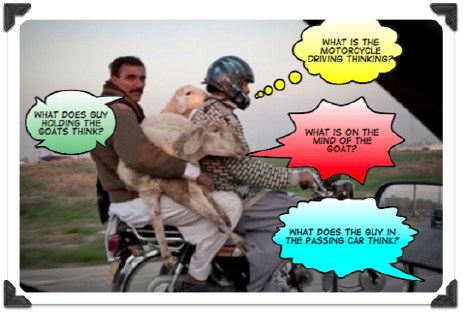
This Associated Press picture from Emilio Morenatti of two goats (or is it sheep?) being carried at the back of a motorcycle on a road on the outskirts of Islamabad is quite funny.
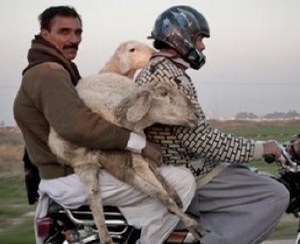 One wonders what the cast of characters is thinking. Maybe you can help us here. What might the guy at the back carrying the goat be thinking to himself? Or the driver of the motorcycle? And what about the goat; what thoughts might be passing through its mind? And, finally, what do you think the person in the car from which the photograph was taken is thinking as he sees this? Any thoughts?
One wonders what the cast of characters is thinking. Maybe you can help us here. What might the guy at the back carrying the goat be thinking to himself? Or the driver of the motorcycle? And what about the goat; what thoughts might be passing through its mind? And, finally, what do you think the person in the car from which the photograph was taken is thinking as he sees this? Any thoughts?
Read more...
4/17/09
Inspiration Pakistan: Nehr Waaley Pul Tey
I must confess that the goriness of my last post still leaves me drained and shaken. I offer this picture post on the simpler pleasures of life in Pakistan, partly as a way of shaking myself off the shivers but much more as a way to highlight that not only is another Pakistan possible, another Pakistan actually exists.

It is the Pakistan of this naai (desi barber) in this beautiful picture, from K.M. Chaudary of AP, who has set up his “open-air” barber shop by the canal in Lahore and, while waiting for customers to show up, decides to give himself a little grooming. The charming composition as well as the subject reminds me not only of my own memories (the best shave I ever had - after a period of growing an unruly beard - was from one such naee), but of the fact that very vast majority of Pakistanis are neither robbers who would hold children hostage nor a community of such unbridled anger that it would burn that robber alive. One must never forget this reality either. Largely because this reality gives hope and the possibility of better things. The reality of yesterday only breeds more anger and discontent.
This is not to say that we should ignore or underplay the reality of desperate people brutally burning robbers to death. We at ATP did not. It is to say, however, that the only thing worse than ignoring the ugliness amongst our own is to let it define the entirety of who we are; to let that ugliness make us forget all the beauty that also exists.
The beauty of the simple life lies in the daily struggles of the simple life. But also in the simple joys that give respite from those daily struggles. The life of the average Pakistani is never idyllic. It cannot be. But it is one that can be inspiring. There are few places better than the banks of the canal in Lahore where you can see on display those daily struggles and how people can find ways to enjoy life despite their struggles. Without having to shout at each other, abuse each other, kill or burn each other. This picture set below, also from K.M. Chaudary of AP, show just a few familiar scenes of how.
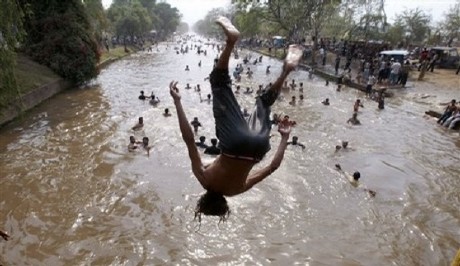
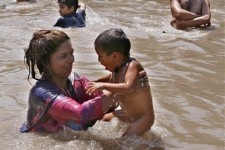
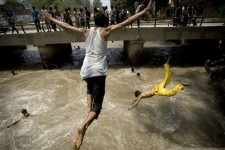
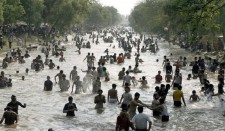
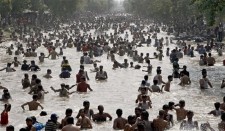
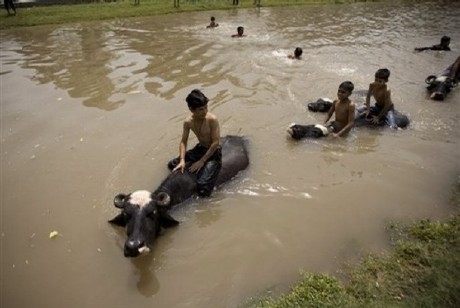
Post Script: Although I have mentioned that evergreen song from Noor Jahan, “Sannu Nehr Waley Pul Te Bulla Kay” in the headline, I will not post it now (even though I love the song) just because it does not quite match the mood of the post (or my own right now). For some reason the song that has been playing in my head today is not the one in the headline above but Baba G.A. Chishti’s epic super-hit “Tangay Walla Khair Mangda.”
As I had suggested in a post a year-and-half ago, that song - probably more than any other - describes (for me) what I and ATP do or are trying to do. Today I seem to be in a mood very similar to what I was feeling when I wrote that post, so I have been replaying that song again and again; in my head and on my computer.
Read more...
Another face of Pakistan
After showing a face of Pakistan, we are back with another face of Pakistan. Photo Credits belong to Abdul Ali . The subject is employed at a road construction project in Quetta.
A face of Pakistan
Owais Mughal
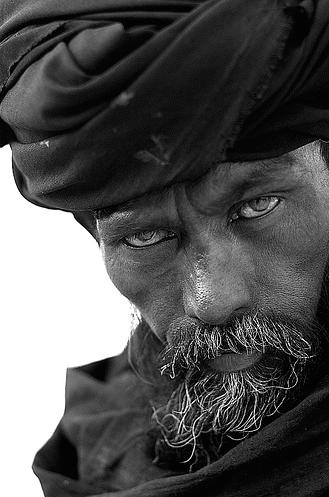
According to Fayyaz’s notes, he found this subject at the tomb of Abdullah Shah Ghazi in Clifton, Karachi. When he asked for the photo permission, the subject replied:
“Whatever you wish”.
I saw this photo for the first time a few days ago but I keep coming back to it again and again. There is something about this guy’s eyes.
Read more...
4/2/09
Stunned, Impressed, or Horrified?
Just in case you miss the point, here is a guy who is:
(a) driving a motorcycle in what seems to be a busy Lahore street (something not recommended for the faint of heart);
(b) tied to the back of the motor cycle is a large, and necessarily heavy, deep-freezer;
(c) he is also talking to his mobile phone (one assumes, hopes, that he received the call, and did not also dial it while riding the motorcycle!);
(d) because of (c) above, he is riding the motorcycle with one hand only; and
(e) he seems so engrossed in his call that he seems to be looking sideways and not really concentrating on the driving or looking ahead.
I look at the photograph and, frankly, I am speechless.
Should I be stunned that someone would even try to pull this off, impressed that he can in fact pull it off, or horrified at how he is imperiling his own and other lives by pulling it off? (To be fair, one cannot be sure whether he did, in fact, pull it off. One sincerely hopes he safely got wherever he was going!)
Read more...
4/1/09
How Many People are on this Motorcycle?
Pictures of overloaded vehicles are nothing special. Not in Pakistan. And our fascinations for rickshaws is also well known. So, why yet another rickshaw picture?
Unless I have it terribly wrong, what we have here is really an ordinary motorcycle - probably not 7occ, maybe more like 140cc (what do you think, Owais?) - that has been retrofitted to become a people-carrier. All very good till here.
But the question is, how many people are riding on this, well, motorcycle? And did they just break any records without even knowing about it?
By my count, there are at least 9 people on this (3 in the front, four in the back, at least 2 hanging), and maybe as many as 12!
Even by Pakistani standards, that is impressive (and really really dangerous!).
Has anyone here seen worse? Or better? [Depending on what you consider worse, or better!]
Read more...
3/29/09
Selling Computers by Weight in Pakistan
A business in Malir, Saudabad (Karachi) is selling working Computers by weight. The ad guarantees Pentium IV microprocessor PCs available in 10 or 15 kilogram versions.
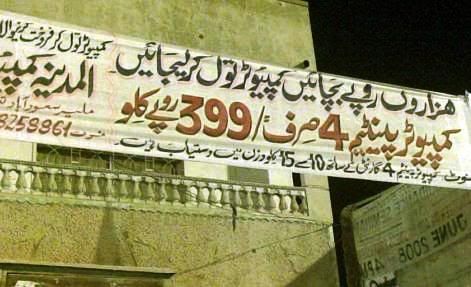
The first line of the ad reads:
save thousands of rupees. Buy computers by weight
Main text in red reads:
Pentium IV Computers (available) at Rupees 399 [approx. US$6] per kilogram onlyDoes it show abundance of PC hardware in Pakistan? or is the country fast becoming a dumping ground for old PCs from rest of the world.
Read more...
A Thousand Words: Badalta hai rang aasmaan
These pictures need no commentary. Click on pictures to link to related posts on ATP Blog.
Read more...
Classroom Cricket: Simple Pleasures
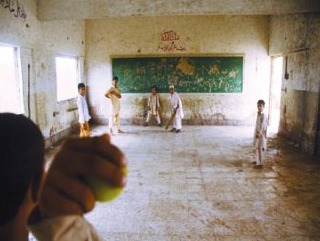 This picture depicts the simple pleasures of youth, but also a sad reality.
This picture depicts the simple pleasures of youth, but also a sad reality.
Here are children playing cricket in a class room of an abandoned school, in Sector 4 of Korangi, Karachi. This photo appeared in the daily Dawn of September 14, 2008.
The sad part is that this school was completed in April 2003 but has not seen regular classes yet. Newspaper reports say that that drug addicts have also made home in empty class rooms. May the drug addicts stay away from the kids!
Read more...
A Photo News and a lateefa
I saw following photo at the Associated Press of Pakistan website. I would also like our readers to take a good look at the photo below. The scene is from Rawalpindi on September 7, 2008.
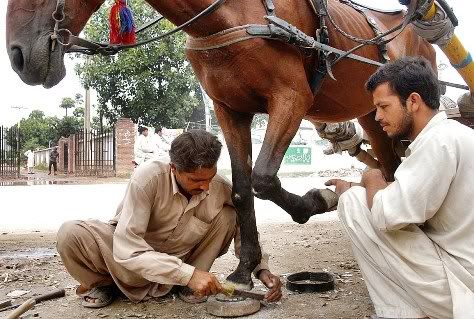
Click on ‘read full post’ to go to the lateefa
The above photo reminded me of a lateefa from one of the Shafiq-ur-Rehman books. The book is called ‘hamaqateN’ and the chapter is ‘neeli jheel’. After watching the above photo news I went to my cabinet and found ‘hamaqateN’ and got this lateefa for our readership.

Photographer of the horse getting its hoofs fixed photo is Javed Qureshi.
Read more...
Khudkush Sale in Lahore
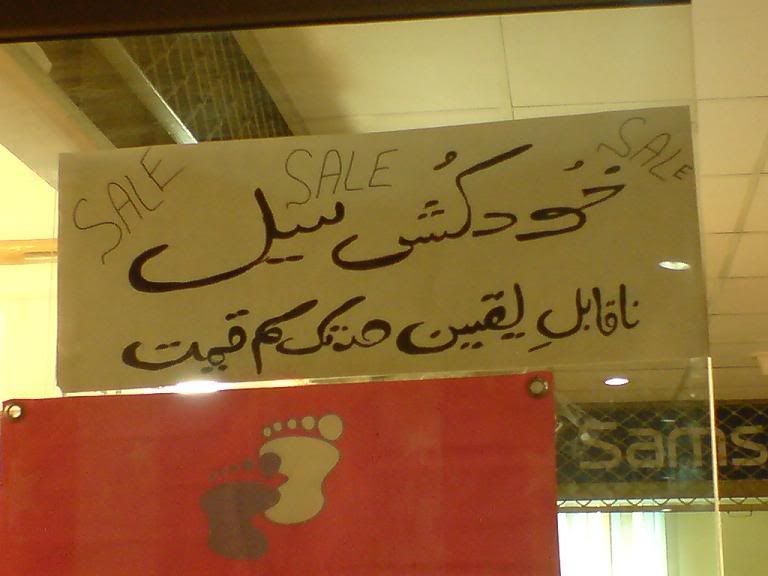
I must say no matter what happens we are a tough nation. Finding our own way through the thick and thin of all times. Even finding humor in the saddest of all situations.
On festive events such as Eid, across Pakistan you will come across punch lines as “Dhamaka Sale Jaari Hay” so often. “Khudkush Sale” (Suicidal Sale) is the new term coined in market.
The shopkeeper was right in thinking that the word “khudkush” will attract everyone. I do hope it doesn’t attract Mr. Khudkhush himself but the genuine buyers only.
Read more...
The Daredevil Electricians of Pakistan
One could argue whether this is the most important issue facing Pakistan today? No it is not. But it is an issue on which I am qualfied to write about because of my profession. What you will see below is a series of photos where Pakistani Electricians (and general public) are seen working on distribution and transmission lines without much regard to their safety.
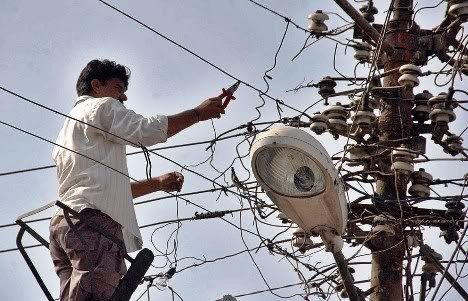
The photo above is from September 23, 2008. Photographer is Jehangir Khan (Associated Press). The subject is a staff technician of KESC working on distribution lines in Saddar, Karachi.
The daredevil mentality persists where Electricians over look safety measures thinking they know it all. They think if nothing has happened to them in all these years, then nothing will happen to them in the future because of their experience. Sometimes they even think it is below their macho image to wear protective equipment. It is true that these electricians may have knowledge of basic rules of electricity and physics but mistakes and accidents do happen and in such circumstances, I believe these guys and our utility companies (WAPDA and KESC) are very ill prepared.
Following photo is from May 23, 2008 and taken in Daska (near Sialkot). Two WAPDA electricians are seen working on a Pole Mounted Transformer (PMT) on Jamke Road. They are wearing hard hats and insulated gloves which is all good. However, the clothing of both men is loose and a hazard in itself.
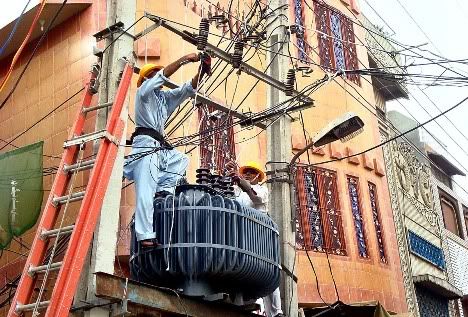
An overriding priniple of electrical saftery is to de-energize the circuit first and place it into electrically safe condition before people can work on it.
 This safe practice is however not always followed. In Pakistan (and also in rest of the world), electricians do work on live circuits all the time. In such cases, an equal blame can be put on WAPDA and KESC who allow their workers to work on live circuits without adequate protection or safety measures. In most parts of the world an employer (WAPDA and KESC for Pakistan) are repsonsible to provide Personal Protective Equipment (PPE) to their staff. The only exception usually is rubber sole shoes which a technician is supposed to buy himself/herself.
This safe practice is however not always followed. In Pakistan (and also in rest of the world), electricians do work on live circuits all the time. In such cases, an equal blame can be put on WAPDA and KESC who allow their workers to work on live circuits without adequate protection or safety measures. In most parts of the world an employer (WAPDA and KESC for Pakistan) are repsonsible to provide Personal Protective Equipment (PPE) to their staff. The only exception usually is rubber sole shoes which a technician is supposed to buy himself/herself.
Photo to the right is from July 07, 2008 in Karachi. The KESC guy on the top is wearing insulated glove and is seemed to have some kind of harness around his back. However there is no hard-hat or eye protection. Also their clothing is very loose for this type of work.
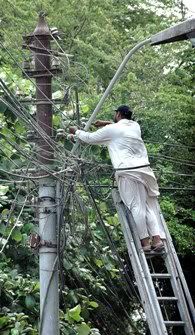 I don’t want to appear to be making comparison of electrical safety with developed countries, but some common sense safety measures should be used by WAPDA and KESC to make sure their electricians are safe. e.g a hard hat, fire resistant clothing, eye glasses, insulated gloves, NO loose clothing (e.g. no shalwar qameez) and some way of making the ladders fall-safe (e.g. harnesses) may be the easiest and cheaper way of ensuring an electrical worker’s safety.
I don’t want to appear to be making comparison of electrical safety with developed countries, but some common sense safety measures should be used by WAPDA and KESC to make sure their electricians are safe. e.g a hard hat, fire resistant clothing, eye glasses, insulated gloves, NO loose clothing (e.g. no shalwar qameez) and some way of making the ladders fall-safe (e.g. harnesses) may be the easiest and cheaper way of ensuring an electrical worker’s safety.
photo to the left above is from July 21, 2008 in Karachi. The KESC technician is working in loose shalwar qameez and without even insulated gloves. This is what I call the dare devil mentality. This technician may be very experienced but he is putting himself (and all his dependents) in unnecessary risk by not wearing protective equipment,
As a bare minimum WAPDA/KESC should atleast properly equip the guy who is climbing the ladder to work on live circuits. The staff which is on the ground may afford not to wear Protective equipment because they are at a distance from live circuits.
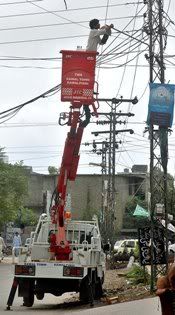 Photo to the right is from Rawal Town Rawalpindi. I am glad to see utility vehicles like this in use by WAPDA in Rawalpindi. One can see the support jacks on one side lifting the vehicle tires to provide a non-slipping non-tipping-over support. I can also see an insulated glove in one hand of the electrician, however he is missing a hard-hat, eye protection and FR clothing.
Photo to the right is from Rawal Town Rawalpindi. I am glad to see utility vehicles like this in use by WAPDA in Rawalpindi. One can see the support jacks on one side lifting the vehicle tires to provide a non-slipping non-tipping-over support. I can also see an insulated glove in one hand of the electrician, however he is missing a hard-hat, eye protection and FR clothing.
One of the most common hazards faced by a WAPDA or KESC electrician is a fiery explosion which may happen by an accident like dropping one’s tool on live circuits and thus shorting them. When such an electrical explosion happens, it causes the surrounding air to ionize and become conductive. In such case an electrical arc is formed through the air. Such arcs can release tremendous amount of energy. The ionized gases expand in volume exponentially along with the molten vapor from conductors. The temperature in the vicinity of faults also increases to such high degrees (~5000 F) that a person can get serious burns. Eye sight and hearing losses are also common besides the staggering medical costs.
Following four photos show WAPDA staff all across Pakistan being ill equipped for Protective Equipment while installing or servicing distribution transformers.

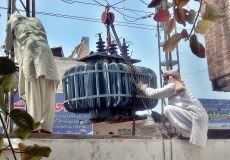

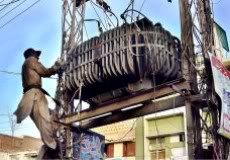
These transformer installation photos in clockwise fashion are from Lahore, Nowshera Virkan, Rahimyar Khan and Quetta.
Electrical Hazard During Rains:
The electricity hazard to technicians increases during rains. Eventhough water itself is a poor conductor but when mixed with impurities like salt, acid, solvents etc it becomes a good conductor. It also turns other substances, which are normally insulators under dry condition into conductors when wet e.g. the wooden ladder on which electricians climb to work on a fault.
The same is true of human skin. Dry skin has a fairly high resistance to electric current. But when skin is moist or wet, it acts as a conductor. This means that anyone working with electricity in a damp or wet environment needs to exercise extra caution to prevent electrical hazards.
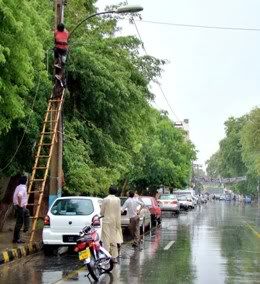 Look at the photo to the right. It was taken in July 2008 in Multan. The WAPDA electrician is working in wet conditions without any safeguards. He is using wooden ladder which becomes a conductor in rains. There is no hard hat and there is no harness if he slips while climbing.
Look at the photo to the right. It was taken in July 2008 in Multan. The WAPDA electrician is working in wet conditions without any safeguards. He is using wooden ladder which becomes a conductor in rains. There is no hard hat and there is no harness if he slips while climbing.
The Menace of Illegal ‘hooks’ Increases Danger for All:
In the past few years I’ve also noticed the mushrooming menace of illegal hook (kunda) connections. These illegal hooks use wires which are not always insulated and used without any routing protocol.
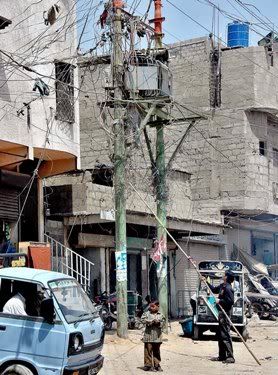 Look at the photo to the left. It was taken in March 2008 in Karachi. A seemingly teenage boy is using a wooden pole to illegaly place a ‘hook’ connection on a live distrbution circuit. He is also oblivious to the presence of a little boy in the vicinity and the danger it poses in case the conductor wire breaks loose and falls.
Look at the photo to the left. It was taken in March 2008 in Karachi. A seemingly teenage boy is using a wooden pole to illegaly place a ‘hook’ connection on a live distrbution circuit. He is also oblivious to the presence of a little boy in the vicinity and the danger it poses in case the conductor wire breaks loose and falls.
The illegal hooked wires criss cross with dangerous proximity to each other and sway like a swing in breeze. Any electrician who now goes to work on circuits with illegal hook-connections in the vicinity increases danger on himself by many folds.
By the way all the photos below show illegal (but working) electricity distribution in different area of Karachi, where people have hooked on to KESC distribution network. Can you imagine a technician going here to fix a circuit or to even find which wire is routed where. This is unbelivable.

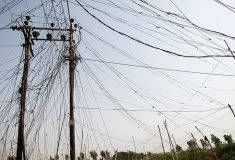
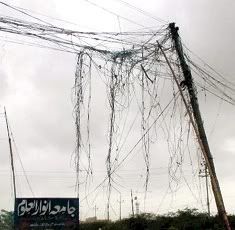
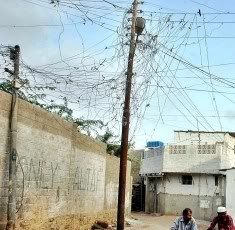
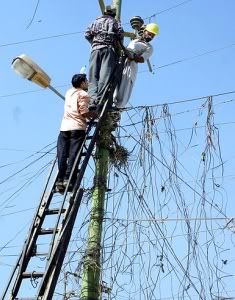
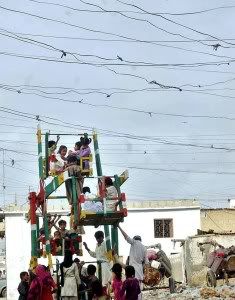
I believe a strong law enforcement is needed to stop power theft via hooks, which will also increase safety of people as well as workers in the vicinity.
Hyderabad’s Share of Daredevils:
While rest of the country has got their share of unprotected devil-may-care electricians then why should the city of Hyderabad remain behind? Following two photos were taken in the month of March and July 2008 respectively. They show WAPDA employees in Hyderabad working on distribution circuits quite unprotected.
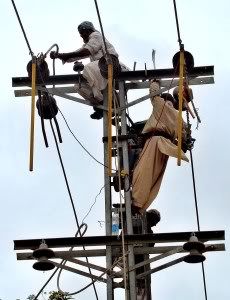
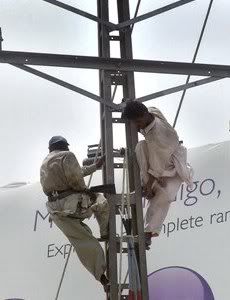
One For the Mocking Bird:
I want to present following photo to lighten up the topic a bit. This photo was taken in Azizabad Karachi and shows a group of pigeons idling up en-masse on a 220V AC, Three Phase distribution Line. Ofcourse they are not wearing any protective equipment. So how come birds in this photo don’t require any protection from electricity? Should we make it (..ahem) an ATP quiz?
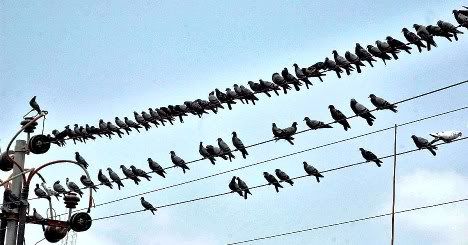
The Poetic End to This Post:
hamare daur meiN zinda hai Mir ka misra
kisi se jiski haqeeqat Dhaki chupi na rahi
nizam-e-barq lia WAPDA na haathoN meiN
phir os ke baad ‘charaaghoN meiN roshni na rahi’
Read more...

 Governmetn websites:
Governmetn websites:









 Election Commission
of
Pakistan
Election Commission
of
Pakistan 


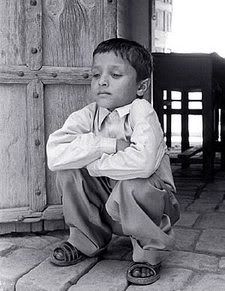 (Note: I post this today from Paris, France; a place that celebrates this date - May 1, Labour Day - quite seriously. This post was first carried at ATP in September 2006, but it is still relevant, especially in the context of child labor, and deserves more attention this Labor Day. AN).
(Note: I post this today from Paris, France; a place that celebrates this date - May 1, Labour Day - quite seriously. This post was first carried at ATP in September 2006, but it is still relevant, especially in the context of child labor, and deserves more attention this Labor Day. AN). We hope you will remember the poem but this post is really about the subject of the poem and of this video. The subject of the state of children in Pakistan.
We hope you will remember the poem but this post is really about the subject of the poem and of this video. The subject of the state of children in Pakistan. Pakistan is signatory of UN Convention on Rights of the Child (CRC) and other ILO Conventions and its national policies condemn child labor and forced labor, but the situation on ground is different. We have domestic child labor, child labor in informal settings like children working in workshops, washing cars in the streets, working on restaurants, begging, child trafficking and rural sector child labor etc.
Pakistan is signatory of UN Convention on Rights of the Child (CRC) and other ILO Conventions and its national policies condemn child labor and forced labor, but the situation on ground is different. We have domestic child labor, child labor in informal settings like children working in workshops, washing cars in the streets, working on restaurants, begging, child trafficking and rural sector child labor etc.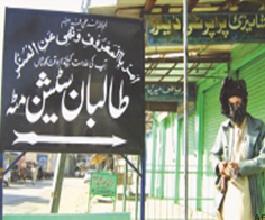 The Taliban onslaught against Pakistan continues relentlessly. The feeling of a polity unraveling before our eyes deepens.
The Taliban onslaught against Pakistan continues relentlessly. The feeling of a polity unraveling before our eyes deepens.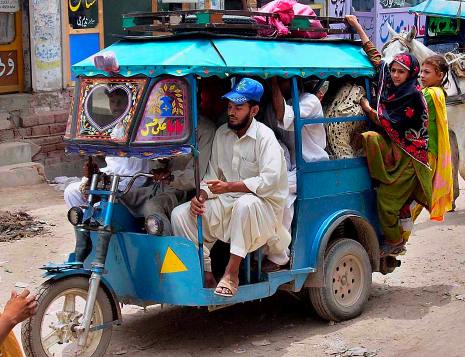
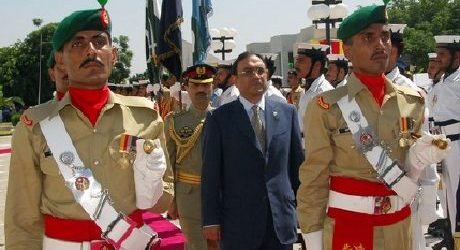

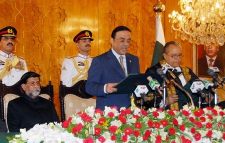
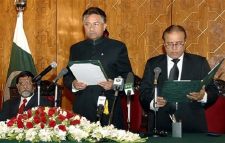









 English Newspapers
English Newspapers
















 Dars-e-Quraan
Dars-e-Quraan Dr. Israr Ahmad
Dr. Israr Ahmad 